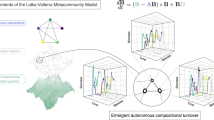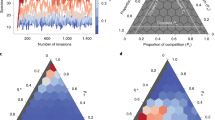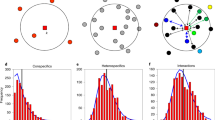Abstract
The assembly of an ecosystem such as a tropical forest depends crucially on the species interaction network, and the deduction of its rules is a formidably complex problem1. In spite of this, many recent studies2,3,4,5,6,7,8,9,10,11,12,13,14,15,16 using Hubbell’s neutral theory of biodiversity and biogeography2 have demonstrated that the resulting emergent macroscopic behaviour of the ecosystem at or near a stationary state shows a surprising simplicity reminiscent of many physical systems17. Indeed the symmetry postulate2, that the effective birth and death rates are species-independent within a single trophic level, allows one to make analytical predictions for various static distributions such as the relative species abundance3,4,5,6,7,8,9,10,11,12, β-diversity13,14,15 and the species–area relationship16. In contrast, there have only been a few studies of the dynamics and stability of tropical rain forests18,19,20. Here we consider the dynamical behaviour of a community, and benchmark it against the exact predictions of a neutral model near or at stationarity. In addition to providing a description of the relative species abundance, our analysis leads to a quantitative understanding of the species turnover distribution and extinction times, and a measure of the temporal scales of neutral evolution. Our model gives a very good description of the large quantity of data collected in Barro Colorado Island in Panama in the period 1990–2000 with just three ecologically relevant parameters and predicts the dynamics of extinction of the existing species.
This is a preview of subscription content, access via your institution
Access options
Subscribe to this journal
Receive 51 print issues and online access
$199.00 per year
only $3.90 per issue
Buy this article
- Purchase on Springer Link
- Instant access to full article PDF
Prices may be subject to local taxes which are calculated during checkout



Similar content being viewed by others
References
Montoya, J. M., Pimm, S. L. & Solé, R. Ecological networks and their fragility. Nature 442, 259–264 (2006)
Hubbell, S. P. The Unified Neutral Theory of Biodiversity and Biogeography (Princeton Univ., New Jersey, 2001)
Bell, G. Neutral macroecology. Science 293, 2413–2418 (2001)
Chave, J. Neutral theory and community ecology. Ecol. Lett. 7, 241–253 (2004)
Bell, G. The distribution of abundance in neutral communities. Am. Nat. 155, 606–617 (2000)
McKane, A., Alonso, D. & Solé, R. V. Mean-field stochastic theory for species-rich assembled communities. Phys. Rev. E 62, 8466–8484 (2000)
Volkov, I., Banavar, J. R., Hubbell, S. P. & Maritan, A. Neutral theory and relative species abundance in ecology. Nature 424, 1035–1037 (2003)
Pigolotti, S., Flammini, A. & Maritan, A. Stochastic model for the species abundance problem in an ecological community. Phys. Rev. E 70, 011916 (2004)
Volkov, I., Banavar, J. R., He, F., Hubbell, S. P. & Maritan, A. Density dependence explains tree species abundance and diversity in tropical forests. Nature 438, 658–661 (2005)
Alonso, D. & McKane, A. Sampling Hubbell’s neutral theory of biodiversity. Ecol. Lett. 7, 911–914 (2004)
Alonso, D., Etienne, R. S. & McKane, A. J. The merits of neutral theory. Trends Ecol. Evol. 21, 451–457 (2006)
Etienne, R. S. & Alonso, D. A dispersal-limited sampling theory for species and alleles. Ecol. Lett. 8, 1147–1156 (2005)
Chave, J. & Leigh, E. G. Jr. A spatially-explicit model of β-diversity. Theor. Popul. Biol. 62, 153–168 (2002)
Condit, R. et al. Beta-diversity in tropical forest trees. Science 295, 666–669 (2002)
Zillio, T., Volkov, I., Banavar, J. R., Hubbell, S. P. & Maritan, A. Spatial scaling in model plant communities. Phys. Rev. Lett. 95, 098101 (2005)
Durrett, R. & Levin, S. A. Spatial models for species area curves. J. Theor. Biol. 179, 119–127 (2002)
Harte, J. Tail of death and resurrection. Nature 424, 1006–1007 (2003)
Clark, J. S. & McLachlan, J. S. Stability of forest biodiversity. Nature 423, 635–638 (2003)
Condit, R. et al. Dynamics of the forest communities at Pasoh and Barro Colorado: comparing two 50-ha plots. Phil. Trans. R. Soc. Lond. B 354, 1739–1748 (1999)
Sheil, D., Jennings, S. & Savill, P. Long-term plot observations of vegetation dynamics in Budongo, a Uganda rain forest. J. Trop. Ecol. 16, 765–800 (2000)
Gilbert, B., Laurance, W. F., Leigh, E. G. & Nascimento, H. E. M. Can neutral theory predict the responses of amazonian tree communities to forest fragmentation?. Am. Nat. 168, 304–317 (2006)
Gonzalez, A., Lawton, J. H., Gilbert, F. S., Blackburn, T. M. & Evans-Freke, I. I. Metapopulation dynamics, abundance, and distribution in a microsystem. Science 281, 2045–2047 (1998)
Abramowitz, M. & Stegun, I. A. Handbook of Mathematical Functions (National Bureau of Standards, Gaithersburg, Maryland, 1964).
Foster, D. R. & Zebrick, T. M. Long-term vegetation dynamics and disturbance history of a Tsuga -dominated forest in New England. Ecology 74, 982–998 (1993)
Bush, M. B., Silman, M. R. & Urrego, D. H. 48,000 years of climate and forest change in a biodiversity hot spot. Science 303, 827–829 (2004)
Pimm, S. L., Russell, G. J., Gittleman, J. L. & Brooks, T. M. The future of biodiversity. Science 269, 347–350 (1995)
Adler, P. B. Neutral models fail to reproduce observed species–area and species–time relationships in Kansas grasslands. Ecology 85, 1265–1272 (2004)
Hilborn, R. & Mangel, M. The Ecological Detective. Confronting Models with Data (Princeton Univ. Press, Princeton, New Jersey, 1997)
Preston, F. W. The commonness and rarity of species. Ecology 29, 254–283 (1948)
Acknowledgements
We thank I. Volkov for comments. This work was supported by COFIN 2005, the NSF, NASA and NSF IGERT.
Author information
Authors and Affiliations
Corresponding authors
Ethics declarations
Competing interests
Reprints and permissions information is available at www.nature.com/reprints. The authors declare no competing financial interests.
Supplementary information
Supplementary Notes
This file contains Supplementary Discussion, Supplementary Equations, Supplementary Tables and Supplementary Figures. (PDF 319 kb)
Rights and permissions
About this article
Cite this article
Azaele, S., Pigolotti, S., Banavar, J. et al. Dynamical evolution of ecosystems. Nature 444, 926–928 (2006). https://doi.org/10.1038/nature05320
Received:
Accepted:
Issue Date:
DOI: https://doi.org/10.1038/nature05320
This article is cited by
-
Macroecological dynamics of gut microbiota
Nature Microbiology (2020)
-
Macroecological laws describe variation and diversity in microbial communities
Nature Communications (2020)
-
Tara Oceans: towards global ocean ecosystems biology
Nature Reviews Microbiology (2020)
-
Business ecosystem modeling- the hybrid of system modeling and ecological modeling: an application of the smart grid
Energy Informatics (2019)
-
Ubiquitous abundance distribution of non-dominant plankton across the global ocean
Nature Ecology & Evolution (2018)
Comments
By submitting a comment you agree to abide by our Terms and Community Guidelines. If you find something abusive or that does not comply with our terms or guidelines please flag it as inappropriate.



